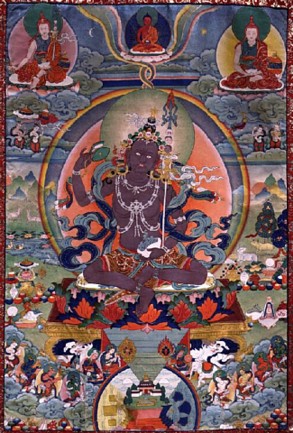Nyingtik Saldrön

Nyingtik Saldrön (Tib. སྙིང་ཐིག་གསལ་སྒྲོན་, Wyl. snying thig gsal sgron) 'The Bright Lamp of the Heart Essence' — a guru yoga practice composed by Jamyang Khyentse Chökyi Lodrö at the request of Tsering Yudrön, a princess of Derge and Nangchen, and Dilgo Khyentse Rinpoche. This particular guru yoga practice with Jamyang Khyentse Rinpoche in his heruka form became especially popular among his disciples. Jamyang Khyentse also wrote a commentary to the practice, called the Yeshe Saldrön.
Prayer of Invocation
It text contains the following invocation:
- chi tar gyalsé chökyi lodrö jé
- In outer form you are the bodhisattva Lord Chökyi Lodrö,
- nang tar jampal trimé shenyen shyap[1]
- Inwardly, you are Manjushri and Vimalamitra,
- sangwa tsen dzok heruka pal la
- Secretly, you are the Glorious Heruka with perfect attributes,
- solwa depso dak gyü chin gyi lop
- Grant me the blessings to change my mindstream, I pray!
- Mantra for invoking the wisdom mind:
- om ah hung guru shri pema heruka sarwa siddhi pala hung[2]
Text
Tibetan
- bla ma'i rnal 'byor snying thig gsal sgron/ in ’Jam dbyangs chos kyi blo gros kyi gsung ’bum. 12 vols. Bir: Khyentse Labrang, 2012. W1KG12986 Vol. 10: 111–115. Available here:
 ༄༅། །བླ་མའི་རྣལ་འབྱོར་སྙིང་ཐིག་གསལ་སྒྲོན་བཞུགས་སོ།
༄༅། །བླ་མའི་རྣལ་འབྱོར་སྙིང་ཐིག་གསལ་སྒྲོན་བཞུགས་སོ།
English Translation
- The Bright Lamp of the Heart Essence: A Guru Yoga, Rigpa Translations, edited and adapted for Lotsawa House. Avaliable here:
 The Bright Lamp of the Heart Essence: A Guru Yoga
The Bright Lamp of the Heart Essence: A Guru Yoga
Commentaries
- Jamyang Khyentse Chökyi Lodrö, Yeshe Saldrön (Tib. ཡེ་ཤེས་གསལ་སྒྲོན་, Wyl. ye shes gsal sgron), JKCL sungbum vol. II.
- In English: Jamyang Khyentse Chökyi Lodrö, The Lamp that Illuminates Wisdom (Rigpa Translations)
- Dilgo Khyentse Rinpoche, བསླབ་གྲོལ་ཡོན་ཏན་དགེ་བ་འཇམ་དབྱངས་རྒྱལ་མཚན་ལ་ཕུལ་བ།, bslab grol yon tan dge ba 'jam dbyangs rgyal mtshan la phul ba, Collected Works, vol. 3, pp. 467-470.
- In English: A Letter of Advice for Practising The Bright Torch of the Innermost Essence (Rigpa Translations)
Notes
- ↑ There are different versions of this line. Some editions have Tib. དང་ dang, but according to the Gangtok edition of Jamyang Khyentse's collected works, the line ends in Tib. ཞབས་ shyap (Wyl. zhabs). Alak Zenkar Rinpoche has confirmed that this is the correct version.
- ↑ Different versions of the mantra are given in different editions of the text. Some version omit the syllable pala (Wyl. pha la), although this appears to be a mistake as the syllable does appear in the commentary. In addition, the commentary mentions the syllable hung only once, when it appears at the end of the mantra.